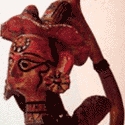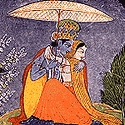The pottery in Rajasthan has several distinct characteristics. Since water is such a precious commodity here, water pots have small mouths to prevent spilling. The shoulders of the pots are painted with black and white patterns. Alwar is noted for its paper thin pottery, known as kagzi pottery. This has extremely thin walls and is very light-weight. The double-walled surface is cut into different attractive patterns to help circulate the air and keep the water cool. The pottery in Pokhran has geometrical etchings. The painted pottery of Bikaner has lac colours to which gold has been added. The Nohar centre of Bikaner is famous for terracotta products.
Beautiful terracotta horses for religious offerings are made in Jallore and Ahora districts while terracotta toys of Nagaur and Merta are popular articles sold in local fairs. The main pottery centres in Rajasthan are Jaipur, Ajmer, Bharatpur, Sikar, and Sawaimadhopur.
The craft of terracotta is practiced widely in Sawai Madhopur of Rajasthan. Products such as decorative figurines of animals, decorative plaques, votive plaques, idols, toys, and pots are produced under this craft-form. Tools such as potter’s wheel called chak, finishing tool called bhal and tools for engraving decorative patterns are required for the crafting process.
In Rajasthan the craftspersons from Pokaran (Pokharan) produce an unusual pottery that is light pink to an almost white colour and has a fine textured feel. These properties are unusual and unlike the red terracotta pottery as the process and techniques followed here are detailed and complex. It is a laborious and time taking procedure that involves beating and grinding the clay by the craftspersons that results in its particular texture and fineness. As the raw clay from this area of the Thar Desert is salty, hard, stony and has rocky ridges the process of refinement requires great skill since it is quite arduous to manipulate the clay in order to craft the items.
To achieve the smooth texture and remove uneven particles, the clay needs to be filtered multiple times through a sieve. Once the clay is molded into the desired shape, it is fired. The Pokaran products are reputed to be durable, tough and are known to be long lasting. At every stage of making the master’s expertise and careful judgment plays a part in producing the final product.
Craftsmen of the caste of Kumbhakars prepare hand crafted products. These include the well known floating clay lamps and lamps in the shape of tortoise and fish bowl for curds, girdle, to make bread. They also shape animals of variety more than 100, including snail, elephant, giraffe, horse, camel, pig, bull, cat, dog, rabbit, camel cart, owl, duck, crocodile, peacock, birds, cock, cow, Nandi, fish, frog, etc.; wall hangings with different animal head shapes, pots with figures of men and women.
Besides creating terracotta pots and vessels, local potters also produce a variety of clay toys and idols in Rajasthan. Idols of Ganesha and Ramdeo, toys such as camels, lions, peacocks, elephants, horse, rats and rabbits and other animal figurines are created under this craft-form. Tools such as potter’s wheel, moulds and carving tools are used for the crafting process.
Gallery
YOUR VIEWS
PRACTITIONERS: INDIA
Access 70,000+ practitioners in 2500+ crafts across India.
BIBLIOGRAPHY
10,000+ listings on arts, crafts, design, heritage, culture etc.
GLOSSARY
Rich and often unfamiliar vocabulary of crafts and textiles.
SHOP at India InCH
Needs to be written.






